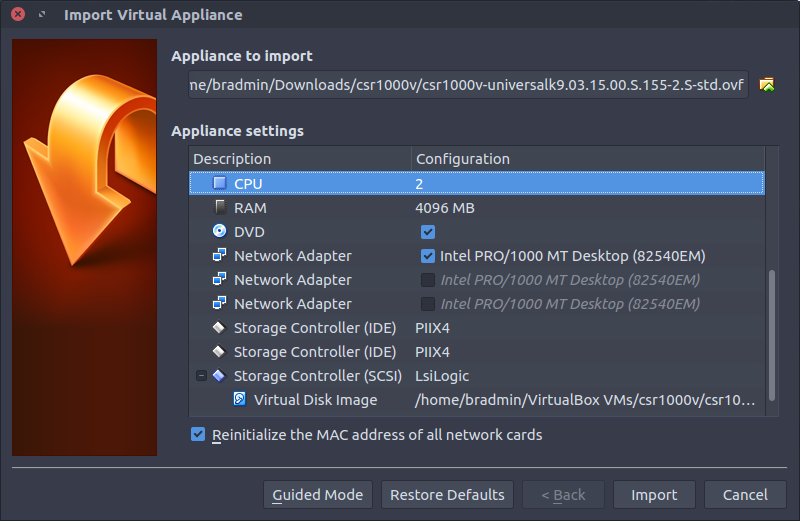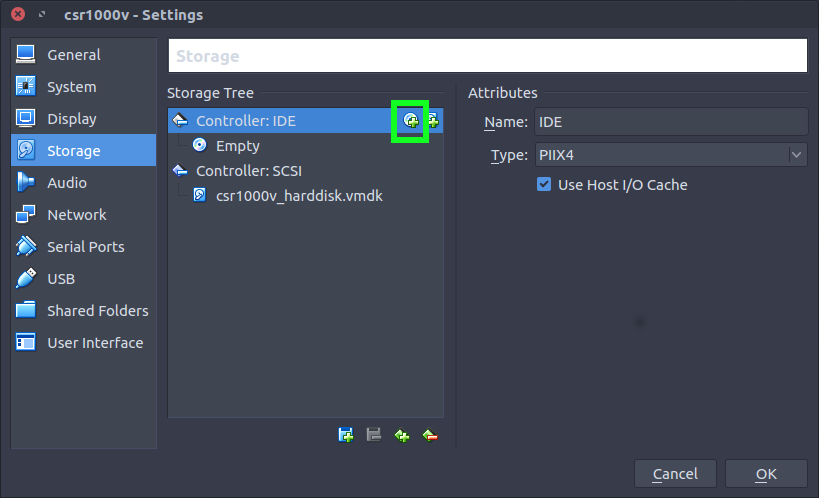Cisco CSR 1000v Vagrant Box Install
published: 13th of August 2017
Intro
This blog covers how to install Cisco csr1000v boxes for use with Vagrant. Cisco does not provide a csr1000v Vagrant box so similar to my other post on creating a Vagrant box from the ASAv ova, I will show you how to create a csr1000v Vagrant box. This post assumes that you already have a working Vagrant install.
Code versions used- csr1000v - 3.15.00.S.155-2.S
- Virtual Box - 5.1.26 r117224
- Vagrant - 1.9.6
- Ubuntu - 1604
Download
Go to the Cisco software download section and search for csr1000v. When you get to the product page download the .ova file.

Import OVA
Browse to the location of the .ova file and extract it.
# lcreate directory and extract ova file
mkdir csr1000v
tar -xvf csr1000v-universalk9.03.15.00.S.155-2.S-std.ova -C csr1000v
# output
csr1000v-universalk9.03.15.00.S.155-2.S-std.ovf
csr1000v-universalk9.03.15.00.S.155-2.S-std.mf
csr1000v_harddisk.vmdk
bdeo.sh
README-OVF.txt
README-BDEO.txt
cot.tgz
csr1000v-universalk9.03.15.00.S.155-2.S-std.isoRemove the .mf files or the VM will fail to boot in Virtualbox.
# Remove .mf files
cd csr1000v
rm -f *.mfIn Virutalbox go to: File > Import Appliance... and browse to the folder from the previous step and import the csr1000v-universalk9.03.15.00.S.155-2.S-std.ovf file.

- CPUs - 2
- RAM - 4096 MB
- Network Adapters - 1
Keep the network adapter type as Intel PRO/1000 MT Desktop (82540EM) and select the tick box to reinitialize the MAC addresses.

Once imported, open the virtual machines settings.

For adapter 1 attach the adapter to a network type that will get an IP address you can SSH to. A bridged adapter will get an IP address from my wireless network so I am using that for simplicity.

Add a serial port but leave it as disconnected.

Connect the ISO image as a CD drive.


Browse to the location of the extracted .ova and select the ISO image.

When attached it looks like this.

Bootstrap Configuration
Boot up the CSR and apply the bootstrap configuration.
# Bootstrap config
en
conf t
hostname csr
ip domain-name lab.local
!
crypto key generate rsa modulus 2048
ip ssh version 2
!
aaa new-model
!
aaa authentication login default local
aaa authorization exec default local
!
username vagrant privilege 15 secret vagrant
!
interface GigabitEthernet1
description vagrant-management
ip address dhcp
no shutdown
!
endFind the IP address assigned via DHCP.
show ip int brie
Interface IP-Address OK? Method Status Protocol
GigabitEthernet1 10.1.1.152 YES DHCP up upLogin with SSH to configure the vagrant insecure ssh key.
# from bash
ssh vagrant@10.1.1.152
password:Configure the vagrant insecure ssh key.
# vagrant ssh key config
conf t
ip ssh pubkey-chain
username vagrant
key-hash ssh-rsa DD3BB82E850406E9ABFFA80AC0046ED6
!
end
wr mem
exitConfirm you can successfully SSH to the device with the Vagrant SSH key.
# from bash
ssh vagrant@10.1.1.152 -i ~/.vagrant.d/insecure_private_keyIf you can successfully SSH to the device with the SSH key, its time to create the Vagrant box.
Box Install
Poweroff the CSR in Virtualbox and create a Vagrant base box.
vagrant package --base csr1000v
# output
==> csr1000v: Exporting VM...
==> csr1000v: Compressing package to: /home/bradmin/vagrant/boxes/cisco/package.box
# move to base box folder
mv package.box ~/vagrant/boxes/cisco/csr1000v-03.15.00-virtualbox.box
cd ~/vagrant/boxes/cisco/Create a metadata file called csr1000v-03.15.00.json with the following contents.
{
"name": "cisco/csr1000v",
"description": "Cisco CSR1000v",
"versions": [
{
"version": "03.15.00",
"providers": [
{
"name": "virtualbox",
"url": "file:///home/bradmin/vagrant/boxes/cisco/csr1000v-03.15.00-virtualbox.box"
}
]
}
]
}Add the newly created base box to Vagrant.
vagrant box add csr1000v-03.15.00.json
# output
==> box: Loading metadata for box 'csr1000v-03.15.00.json'
box: URL: file:///home/bradmin/vagrant/boxes/cisco/csr1000v-03.15.00.json
==> box: Adding box 'cisco/csr1000v' (v03.15.00) for provider: virtualbox
box: Unpacking necessary files from: file:///home/bradmin/vagrant/boxes/cisco/csr1000v-03.15.00-virtualbox.box
==> box: Successfully added box 'cisco/csr1000v' (v03.15.00) for 'virtualbox'!Confirm Vagrant can see the box.
vagrant box list
# output
CumulusCommunity/cumulus-vx (virtualbox, 3.3.2)
arista/veos (virtualbox, 4.18.1F)
centos/7 (virtualbox, 1705.02)
cisco/asav (virtualbox, 9.8.1)
cisco/csr1000v (virtualbox, 03.15.00)
debian/jessie64 (virtualbox, 8.8.1)
juniper/ffp-12.1X47-D15.4 (virtualbox, 0.5.0)
juniper/ffp-12.1X47-D15.4-packetmode (virtualbox, 0.5.0)
juniper/vqfx10k-pfe (virtualbox, 0.1.0)
juniper/vqfx10k-re (virtualbox, 0.2.0)
ubuntu/xenial64 (virtualbox, 20170728.0.0)Create a directory for testing the Vagrant environment.
mkdir ~/vagrant/csr-test; cd ~/vagrant/csr-test/Use this sample Vagrantfile.
# -*- mode: ruby -*-
# vi: set ft=ruby :
Vagrant.configure("2") do |config|
config.vm.box = "cisco/csr1000v"
# Turn off shared folders
config.vm.synced_folder ".", "/vagrant", id: "vagrant-root", disabled: true
# Do not try to insert new SSH key
config.ssh.insert_key = false
# Give the VM time to boot as Vagrant cannot tell when it is booted
config.vm.boot_timeout = 400
# Additional interfaces
config.vm.network "private_network", ip: "169.254.1.11", auto_config: false
config.vm.network "private_network", ip: "169.254.1.12", auto_config: false
endTesting Vagrant Box
Lets get building, vagrant up and confirm the CSR box builds correctly.
vagrant up
# output
Bringing machine 'default' up with 'virtualbox' provider...
==> default: Importing base box 'cisco/csr1000v'...
==> default: Matching MAC address for NAT networking...
==> default: Checking if box 'cisco/csr1000v' is up to date...
==> default: Setting the name of the VM: cisco-test_default_1502597160552_57639
==> default: Clearing any previously set network interfaces...
==> default: Preparing network interfaces based on configuration...
default: Adapter 1: nat
default: Adapter 2: hostonly
default: Adapter 3: hostonly
==> default: Forwarding ports...
default: 22 (guest) => 2222 (host) (adapter 1)
==> default: Booting VM...
==> default: Waiting for machine to boot. This may take a few minutes...
default: SSH address: 127.0.0.1:2222
default: SSH username: vagrant
default: SSH auth method: private key
==> default: Machine booted and ready!
==> default: Checking for guest additions in VM...
default: No guest additions were detected on the base box for this VM! Guest
default: additions are required for forwarded ports, shared folders, host only
default: networking, and more. If SSH fails on this machine, please install
default: the guest additions and repackage the box to continue.
default:
default: This is not an error message; everything may continue to work properly,
default: in which case you may ignore this message.Login to device and test.
vagrant ssh
# output
csr#show version
Cisco IOS XE Software, Version 03.15.00.S - Standard Support Release
Cisco IOS Software, CSR1000V Software (X86_64_LINUX_IOSD-UNIVERSALK9-M), Version 15.5(2)S, RELEASE SOFTWARE (fc3)
Technical Support: http://www.cisco.com/techsupport
Copyright (c) 1986-2015 by Cisco Systems, Inc.
Compiled Sun 22-Mar-15 01:36 by mcpre
Cisco IOS-XE software, Copyright (c) 2005-2015 by cisco Systems, Inc.
All rights reserved. Certain components of Cisco IOS-XE software are
licensed under the GNU General Public License ("GPL") Version 2.0. The
software code licensed under GPL Version 2.0 is free software that comes
with ABSOLUTELY NO WARRANTY. You can redistribute and/or modify such
GPL code under the terms of GPL Version 2.0. For more details, see the
documentation or "License Notice" file accompanying the IOS-XE software,
or the applicable URL provided on the flyer accompanying the IOS-XE
software.
ROM: IOS-XE ROMMON
csr uptime is 6 minutes
Uptime for this control processor is 7 minutes
System returned to ROM by reload
System image file is "bootflash:packages.conf"
Last reload reason: <NULL>
This product contains cryptographic features and is subject to United
States and local country laws governing import, export, transfer and
use. Delivery of Cisco cryptographic products does not imply
third-party authority to import, export, distribute or use encryption.
Importers, exporters, distributors and users are responsible for
compliance with U.S. and local country laws. By using this product you
agree to comply with applicable laws and regulations. If you are unable
to comply with U.S. and local laws, return this product immediately.
A summary of U.S. laws governing Cisco cryptographic products may be found at:
http://www.cisco.com/wwl/export/crypto/tool/stqrg.html
If you require further assistance please contact us by sending email to
export@cisco.com.
License Level: ax
License Type: Default. No valid license found.
Next reload license Level: ax
cisco CSR1000V (VXE) processor (revision VXE) with 2067410K/6147K bytes of memory.
Processor board ID 9Q31KM6V7WI
3 Gigabit Ethernet interfaces
32768K bytes of non-volatile configuration memory.
3988236K bytes of physical memory.
7774207K bytes of virtual hard disk at bootflash:.
Configuration register is 0x2102
csr#When you are done, destroy the box.
vagrant destroy -f
# output
==> default: Forcing shutdown of VM...
==> default: Destroying VM and associated drives...Outro
If you followed along you should have a shinny csr1000v Vagrant box for labbing and testing. Although Cisco didn't make it easy we did it any way.